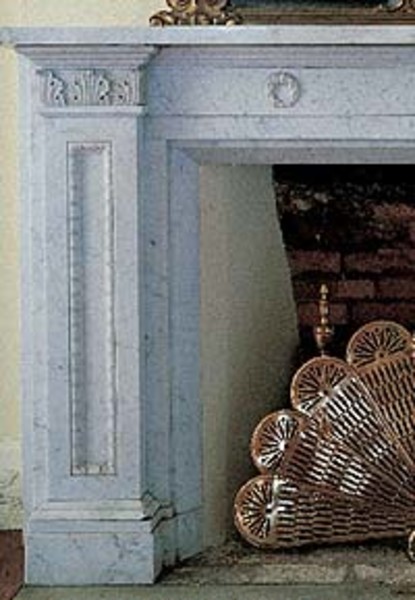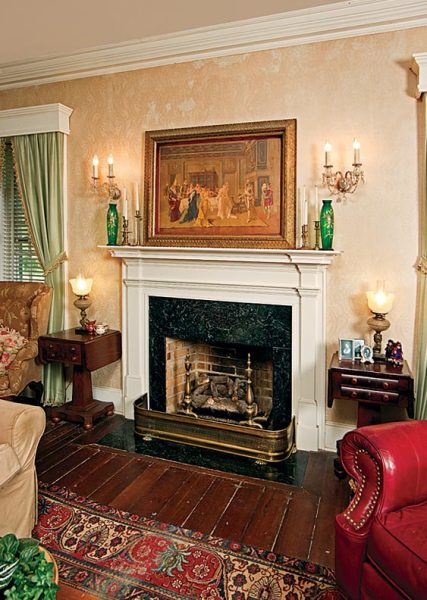
By Mary Ellen Polson
The marble mantel in my apartment is easily the plainest in the building, an 1865 Second Empire row house in Boston’s historic South End. But itÕs still white marble, that lustrous, luxurious material that recalls the snow-white peaks of Carrara– or it would, if only the mantel were clean. When I moved in, the top surface was pitted in places and stained with a combination of soot, rust, and what appeared to be coffee rings. Rust-colored stains and more soot grimed the fireplace surround. I’ve since discovered that stains that looked the toughest cleaned up with a little bit of soap and water, while seemingly innocuous stains despite repeated treatments using an arsenal of chemical weaponry.
Types of Stains
Most stains on marble fall into one of five categories: soot or smoke, oily stains, adhesives, organic stains such as coffee and tea, and rust. If the mantel will come clean at all, each of these problem stains usually responds to a specific solvent that unlocks the stain within the stone. That said, itÕs not always easy to determine the cause of a specific stain. Plan to experiment with several different cleaning agents, particularly if your mantel appears to have multiple types of stains, as mine did.
Since marble is porous and easily damaged by acids or abrasives, teasing out certain stains requires a bit of finesse. While a number of commercial marble cleaners are on the market, it’s relatively easy to create your own cleaning agents, usually with materials available at the local hardware store.
Basic Cleaning
Mix up a sudsy batch of a non-ionic detergent, such as Ivory Liquid, with warm water, and scrub the mantel with a medium-stiff, natural bristle or plastic brush. (Avoid wire brushes, steel wool, or other metal utensils.) Use a toothbrush dipped in suds to clean tight spaces.
If the mantel is still dirty after this initial cleaning, use a stronger cleaning agent–ammonia diluted with water, or full-strength if necessary. Organic stains may respond better to a mix of hydrogen peroxide and water. Be sure to wear rubber gloves to protect your skin when you’re working with these chemicals.
While you can also try a little diluted household bleach on persistent stains, bear in mind that bleach may etch the stone. (Never combine bleach with ammonia; together they produce a toxic gas that can cause severe damage to the respiratory system.)
Recently cleaned marble mantel.
Creating a Poultice
If your mantel is particularly dirty, there will probably be some residual staining and discoloration deep in the pores of the stone. One of the most effective techniques for drawing out persistent stains is to use a poultice made from a thick layer of an absorbent material, activated by the solvent that works best for that type of stain. As a rule, leave the poultice in place for at least 24 hours, under a layer of plastic wrap sealed with painterÕs tape.
The wet poultice allows the solvent to penetrate deeply into the stone. As the poultice gradually dries out, the solvent migrates back into the absorbent material–drawing the stain with it. For best results, the poultice should be at least g thick; the thicker the poultice, the more thoroughly the cleaning agent can work.
Almost any color-neutral absorbent material can be used in a poultice, from shredded toilet paper to commercial poultices formulated specifically for marble. While most of these materials are essentially inert (such as plain paper towels), some contain an active ingredient and should be used for specific types of stains. Baking soda, for instance, is an effective alkaline cleaning agent when wet with water. One caveat: If you’re working with a darker marble, avoid using any of the powders as poultices. The fine particles may settle in the pores. Blotting paper or paper towels are better choices.
Once the poultice has done its work, remove it with a plastic or wooden scraper, preferably before it has thoroughly dried. Wash the marble with mild detergent, then rinse and dry the surface. Now for the bad news: Even if you’ve correctly identified the stain and used the right solvent, you may have to apply the poultice two or three times to completely remove the discoloration. Particularly old or deep-seated stains may not respond to any cleaning method. Smoke and Soot. If you still have dingy gray or yellow stains after a thorough cleaning, mix up a g-thick poultice of baking soda and water. Seal the poultice with either plastic wrap or a layer of damp cloths and leave it in place at least 24 hours, or until almost dry. As an alternative, try diluted liquid chlorine bleach applied directly to the stone.
Italian marble fireplace. Joseph Hilliard
Oily stains. Wax, butter, crayons, even cold cream can eventually soak into marble, creating a persistent stain. Before applying a poultice, clean the area as you would a paint spill–with paint thinner, mineral spirits, naptha, or acetone. If there’s still a residue, use one of the above agents with the poultice method.
Adhesives. To remove sticky substances such as gum or tar, try chilling the area with a piece of dry ice. The intense cold should make the spot brittle and easy to pop off. One warning: make sure the mantel surface is completely dry. Any moisture in the stone could freeze and crack the marble. If thereÕs still a residue, try rubbing the spot with acetone, or if necessary, use an acetone poultice.
Organic stains. Tea, coffee, juices, and dyes transferred from paper and textiles can all leave troublesome stains on porous marble. Try cleaning the stains with diluted or full-strength ammonia, or alternatively, apply a mix of one part hydrogen peroxide and four parts water. If the stains persist, use either full-strength ammonia or 20% hydrogen peroxide as the active ingredient in a thick poultice.
Rust. One of the most stubborn stains, rust can penetrate marble from flower pots, nails, tools, steel wool, and even some types of soil. While you may be tempted to use commercial rust removers that contain oxalic acid, keep in mind that these can etch the surface of the marble. Commercial poultices are often effective on many of these tough stains, although they won’t work in every instance. For the worst rust stains, you may want to try the following process, provided you can locate the necessary chemicals at a local chemical supply house.
Evening the Finish
Once the mantel is as clean as you can get it, you may find the marble has lost its polish. You may be able to restore some sheen by applying a polish formulated specifically for marble. If the surface is still rough after polishing, try a combination of wet-sanding, buffing, and polishing techniques to restore the finish.
Wet-sanding. If the surface is very rough, begin with a 120-grit wet-dry paper, available in hardware stores. If the finish is in relatively good shape, begin with a finer paper, such as 220-grit, and progress to a finishing grade, such as 320. Some darker marbles may require finishing with grades as high as 600-grit. Be sure to keep the surface wet as you work, flushing with water to remove particles.
Buffing. Buff the wet-sanded surface with a moistened felt pad or buffing wheel and a buffing powder, such as tin or aluminum oxide.
Polishing. Apply a good quality marble polish with a soft cloth. Rub the polish into the surface to protect and revive its shine. A little buffing should bring out the full luster of your cleaned and restored marble mantel.







